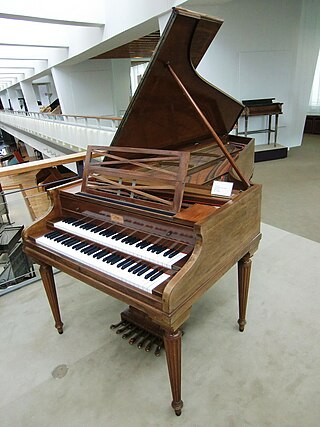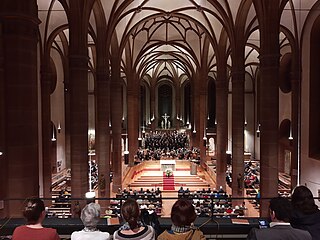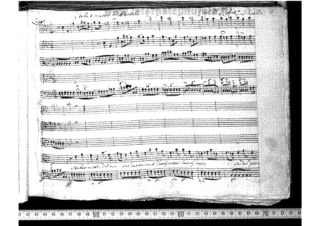Related Research Articles

Concert champêtre, FP 49, is a harpsichord concerto by Francis Poulenc, which also exists in a version for piano solo with very slight changes in the solo part.
The Sonate pour clarinette et piano, FP 184, for clarinet in B-flat and piano by Francis Poulenc dates from 1962 and is one of the last pieces he completed. It is dedicated to the memory of Arthur Honegger, who like Poulenc had belonged to the group Les Six. A typical performance takes 12–14 minutes.
The Sonate pour houtbois et piano, FP 185, is an oboe sonata by Francis Poulenc dating from 1962. The composer's last work, it is dedicated to the memory of Sergei Prokofiev.

Karol Szymanowski's Stała matka bolejąca , Op. 53, was composed in 1925 and 1926. Scored for soprano, alto and baritone soloists, SATB choir and orchestra, it sets Jozef Janowski's Polish translation of the Marian hymn in six movements. His first composition to a liturgical text, it is characteristic of his late period in being partly based on Polish melodies and rhythms; a stay in the Tatras mountains, at Zakopane, in 1922 had led him to describe Polish folk music as "enlivening [in] its proximity to Nature, [in] its force, [in] its directness of feeling, [in] its undisturbed racial purity." Indeed, Szymanowski's use of Polish musical elements together with the Polish translation here is unique.
The Gloria by Francis Poulenc, FP 177, scored for soprano solo, large orchestra, and chorus, is a setting of the Gloria text from the mass ordinary. One of Poulenc's most celebrated works, it was commissioned by the Koussevitsky Foundation in honor of Sergei Koussevitzky and his wife Natalia, the namesakes of the foundation.

Les biches is a one-act ballet to music by Francis Poulenc, choreographed by Bronislava Nijinska and premiered by the Ballets Russes on 6 January 1924 at the Salle Garnier in Monte Carlo. Nijinska danced the central role of the Hostess. The ballet has no story, and depicts the random interactions of a group of mainly young people in a house party on a summer afternoon.

The Sinfonietta, FP 141, is a work for orchestra by Francis Poulenc. Composed in 1947 on a commission from the BBC, it was first performed in London on 24 October 1948, conducted by Roger Désormière. The work, light and full of dance rhythms, is in four movements.

Antonín Dvořák's Stabat Mater, Op. 58 (B. 71), is an extended setting for vocal soloists, choir and orchestra of the 20 stanzas of the Stabat Mater sequence. Dvořák sketched the composition in 1876 and completed it in 1877. It has been characterized as a sacred cantata and as an oratorio, and consists of ten movements of which only the first and the last are thematically connected. Its total performance time is around 85 minutes.
Joseph Haydn's Stabat Mater Hob. XXa:1 was written in 1767, for soprano, alto, tenor and bass soloists, mixed choir, 2 oboes both doubling English horn in the sections in E-flat major, strings and organ continuo. The first performance is believed to have taken place March 25, 1768 in Vienna with soloists Anna Maria Scheffstoss and Carl Friberth, with Haydn conducting from the harpsichord. Conductor Jonathan Green suggests adding a bassoon to double the bass line and perhaps just one player to each string part.
The Concerto pour orgue, cordes et timbales in G minor, FP 93, is an organ concerto composed by Francis Poulenc between 1934 and 1938. It has become one of the most frequently performed pieces of the genre not written in the Baroque period.

Stabat Mater is a work by Gioachino Rossini based on the traditional structure of the Stabat Mater sequence for chorus and soloists. It was composed late in his career after retiring from the composition of opera. He began the work in 1831 but did not complete it until 1841.
Francis Poulenc's Concerto pour deux pianos in D minor, FP 61, was composed over the period of three months in the summer of 1932. It is often described as the climax of Poulenc's early period. The composer wrote to the Belgian musicologist Paul Collaer: "You will see for yourself what an enormous step forward it is from my previous work and that I am really entering my great period." The concerto was commissioned by and dedicated to the Princess Edmond de Polignac, an American-born arts patron to whom many early-20th-century masterpieces are dedicated, including Stravinsky's Renard, Ravel's Pavane pour une infante défunte, Kurt Weill's Second Symphony, and Satie's Socrate. Her Paris salon was a gathering place for the musical avant-garde.
The Stabat Mater is a musical setting of the Stabat Mater sequence, composed by Luigi Boccherini in 1781 and revised in 1800.

Stabat Mater for solo alto and orchestra, RV 621, is a composition by the Italian baroque composer Antonio Vivaldi on one of the Sorrows of Mary. It was premiered in Brescia in 1712.

Stabat Mater (P.77) is a musical setting of the Stabat Mater sequence, composed by Giovanni Battista Pergolesi in 1736. Composed in the final weeks of Pergolesi's life, it is scored for soprano and alto soloists, violin I and II, viola and basso continuo.
Mouvements perpétuels, FP 14a, is a short three-movement solo-piano piece by French composer Francis Poulenc.
Messe en sol majeur, FP 89, is a missa brevis by Francis Poulenc. He set most parts of the Latin mass to music in 1937, scored for a mixed choir a cappella.

Stabat Mater by Alessandro Scarlatti is a religious musical work composed for two voices (soprano/alto), two violins and basso continuo, in 1724, on a commission from the Order of Friars Minor, the "Knights of the Virgin of Sorrows" of the Church of San Luigi in Naples for Lent
Élégie pour cor et piano – Elegy for horn and piano – FP 168 is a short, one-movement work by the French composer Francis Poulenc, written in memory of the horn player Dennis Brain, who died in 1957. It was first performed in January 1958.
References
- ↑ Mellers.
- ↑ Schmidt 1995, p. 409.
- ↑ Francis Poulenc: A Bio-bibliography by George R. Keck, Greenwood Press, 1990
- ↑ Hell.
- ↑ Schmidt 1995.